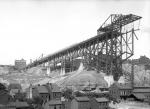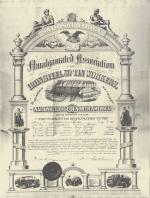![header=[Marker Text] body=[On Feb. 4, 1896, sixteen delegates met at Moorheads Hall here to form the International Association of Bridge, Structural, Ornamental, and Reinforcing Iron Workers. Active in the struggle for health and safety standards, by 1996 it had 140,000 members. ] sign](http://explorepahistory.com/kora/files/1/10/1-A-241-139-ExplorePAHistory-a0h6v9-a_450.jpg)
Mouse over for marker text
Name:
Founding of Ironworkers Union
Region:
Pittsburgh Region
County:
Allegheny
Marker Location:
Grant St. and Boulevard of the Allies, Pittsburgh
Dedication Date:
May 22, 1999
Behind the Marker
-W.C. Aiken, business agent for the Ironworkers' Pittsburgh local.
As W.C. Aiken noted, many early ironworkers led an unsettled, nomadic life, moving continually as they finished one railroad bridge and began work on another. This pattern of itinerant work continued during the early years of steel-framed skyscraper construction at the turn of the century.
The large companies that erected skyscrapers took contracts in all parts of the country, and sent their workers from one city to the next. Structural ironworkers constantly faced the dangers of walking across a narrow beam twenty or more stories above a city street. The work called for calm nerves more than special skills. As a researcher from the U.S. Commission on Industrial Relations put it, "The calling is one that hardly attracts the home-loving married man."
For several years after its founding in 1896, the International Association of Bridge and Structural Ironworkers was a loose federation of five strong locals, in New York, Buffalo, Boston, Pittsburgh, and Chicago. The pioneering Chicago local, formed in the early 1890s, convinced that city's steel-erection firms to accept "closed shop" unionized labor.
In 1901 the Ironworkers, now with twenty-seven locals and 6,000 members, held their first national congress, launched the Bridgemen's Magazine, and soon joined the American Federation of Labor Spectacular bridge accidents, including the Wabash bridge collapse in Pittsburgh in 1903 that killed ten and the 1907 Quebec railroad bridge disaster that killed eighty-six workers, made the union a leader in construction safety efforts. Yet, for the most part, the locals still conducted business with the local construction firms. The Pittsburgh local even rejected a settlement negotiated by the International's leadership during a key 1905 strike at
American Federation of Labor Spectacular bridge accidents, including the Wabash bridge collapse in Pittsburgh in 1903 that killed ten and the 1907 Quebec railroad bridge disaster that killed eighty-six workers, made the union a leader in construction safety efforts. Yet, for the most part, the locals still conducted business with the local construction firms. The Pittsburgh local even rejected a settlement negotiated by the International's leadership during a key 1905 strike at  McKeesport. Samuel Gompers of the AFL would later recall this as "one of the three most costly blunders" made by organized labor.
McKeesport. Samuel Gompers of the AFL would later recall this as "one of the three most costly blunders" made by organized labor.
Soon enough the Ironworkers found themselves locked in the brutal "open shop" battle with the National Erectors' Association. Formed in 1903, the association launched a vigorous antiunion "open shop" campaign three years later. The mammoth American Bridge Company, a U.S. Steel subsidiary, led the association's thirty-odd members, which included also Pennsylvania Steel, Phoenix Bridge, Fort Pitt Bridge Works, and Pittsburgh Construction Co. Generally, New York was a bastion of the open shop, while Chicago remained a stronghold of the closed shop. Pennsylvania stood in between. Erectors in Pittsburgh employed 1,000 open-shop men and 400 union men in 1914.
The Ironworkers hoped to extend their jurisdiction beyond the erecting of steel-framed buildings to include the fabricating of structural steel pieces, done in off-site factories. Members of the National Erectors' Association stubbornly opposed unionized labor in their fabricating mills. A grim litany of strikes, threats, failed negotiations, espionage, and violence typified the open shop war. In most cities, union-scale ironworkers earned 10 to 14 cents per hour more than non-union open-shop workers. In addition, a thicket of conflicts over sub-contracts, work rules, and materials handling defied settlement. But the underlying conflict turned on the very existence of the union.
Spying by the National Erectors' Association generated much resentment and ill will, especially when its spies provoked violence. In 1906 police arrested three ironworkers, including a man named Guthrie, recently admitted to the New Jersey local, for carrying dynamite into a building under construction in downtown New York. While the two other union men were jailed, Guthrie went free on bail, paid by a member of the erectors' New York branch. He promptly disappeared.
The union, facing unyielding resistance from the erectors association and already conducting an ugly "slugging" campaign against non-union workers and foremen, began its own campaign of dynamiting. From 1906 to 1911, the union paid three shadowy troublemakers $200 a pop to plant bombs on certain bridges and buildings under construction.
No one was fatally injured in the campaign until a bomber blew up the Los Angeles Times building in 1910 and killed twenty people. A national sensation erupted. It turned out that this bombing was commissioned not by the Ironworkers' union but instead by "that wild San Francisco bunch" of workers striking against the open shop. All the same, the union's entire leadership was jailed. Opponents of organized labor cited the Ironworkers' campaign as evidence that the entire American labor movement was filled with dangerous radicals. The Bolshevik revolution in Russia in 1917 further stoked fears of the overthrow of capitalism. In the steel strike of 1919, for these reasons, workers faced a difficult time getting a fair public hearing of their case.
steel strike of 1919, for these reasons, workers faced a difficult time getting a fair public hearing of their case.
The labor-friendly reforms of Franklin D. Roosevelt's New Deal effectively brought the employers' open shop campaign to a dead end. In 1937, with a favorable decision in the NLRB v. Jones and Laughlin case, the Ironworkers launched a nationwide organizing campaign that quickly doubled its membership, to 31,700. By 1944 the Ironworkers had just over 100,000 members, and its union leadership from then on focused, as most successful postwar unions did, on the "bread and butter" issues of wages and working conditions.
NLRB v. Jones and Laughlin case, the Ironworkers launched a nationwide organizing campaign that quickly doubled its membership, to 31,700. By 1944 the Ironworkers had just over 100,000 members, and its union leadership from then on focused, as most successful postwar unions did, on the "bread and butter" issues of wages and working conditions.
"The organization has made men of a lot of irresponsible bums. Most of us a few years ago didn't know what it meant to wear a white collar. We were only half civilized; just a lot of bums roaming around the country."
-W.C. Aiken, business agent for the Ironworkers' Pittsburgh local.
As W.C. Aiken noted, many early ironworkers led an unsettled, nomadic life, moving continually as they finished one railroad bridge and began work on another. This pattern of itinerant work continued during the early years of steel-framed skyscraper construction at the turn of the century.
The large companies that erected skyscrapers took contracts in all parts of the country, and sent their workers from one city to the next. Structural ironworkers constantly faced the dangers of walking across a narrow beam twenty or more stories above a city street. The work called for calm nerves more than special skills. As a researcher from the U.S. Commission on Industrial Relations put it, "The calling is one that hardly attracts the home-loving married man."
For several years after its founding in 1896, the International Association of Bridge and Structural Ironworkers was a loose federation of five strong locals, in New York, Buffalo, Boston, Pittsburgh, and Chicago. The pioneering Chicago local, formed in the early 1890s, convinced that city's steel-erection firms to accept "closed shop" unionized labor.
In 1901 the Ironworkers, now with twenty-seven locals and 6,000 members, held their first national congress, launched the Bridgemen's Magazine, and soon joined the
Soon enough the Ironworkers found themselves locked in the brutal "open shop" battle with the National Erectors' Association. Formed in 1903, the association launched a vigorous antiunion "open shop" campaign three years later. The mammoth American Bridge Company, a U.S. Steel subsidiary, led the association's thirty-odd members, which included also Pennsylvania Steel, Phoenix Bridge, Fort Pitt Bridge Works, and Pittsburgh Construction Co. Generally, New York was a bastion of the open shop, while Chicago remained a stronghold of the closed shop. Pennsylvania stood in between. Erectors in Pittsburgh employed 1,000 open-shop men and 400 union men in 1914.
The Ironworkers hoped to extend their jurisdiction beyond the erecting of steel-framed buildings to include the fabricating of structural steel pieces, done in off-site factories. Members of the National Erectors' Association stubbornly opposed unionized labor in their fabricating mills. A grim litany of strikes, threats, failed negotiations, espionage, and violence typified the open shop war. In most cities, union-scale ironworkers earned 10 to 14 cents per hour more than non-union open-shop workers. In addition, a thicket of conflicts over sub-contracts, work rules, and materials handling defied settlement. But the underlying conflict turned on the very existence of the union.
Spying by the National Erectors' Association generated much resentment and ill will, especially when its spies provoked violence. In 1906 police arrested three ironworkers, including a man named Guthrie, recently admitted to the New Jersey local, for carrying dynamite into a building under construction in downtown New York. While the two other union men were jailed, Guthrie went free on bail, paid by a member of the erectors' New York branch. He promptly disappeared.
The union, facing unyielding resistance from the erectors association and already conducting an ugly "slugging" campaign against non-union workers and foremen, began its own campaign of dynamiting. From 1906 to 1911, the union paid three shadowy troublemakers $200 a pop to plant bombs on certain bridges and buildings under construction.
No one was fatally injured in the campaign until a bomber blew up the Los Angeles Times building in 1910 and killed twenty people. A national sensation erupted. It turned out that this bombing was commissioned not by the Ironworkers' union but instead by "that wild San Francisco bunch" of workers striking against the open shop. All the same, the union's entire leadership was jailed. Opponents of organized labor cited the Ironworkers' campaign as evidence that the entire American labor movement was filled with dangerous radicals. The Bolshevik revolution in Russia in 1917 further stoked fears of the overthrow of capitalism. In the
The labor-friendly reforms of Franklin D. Roosevelt's New Deal effectively brought the employers' open shop campaign to a dead end. In 1937, with a favorable decision in the
Beyond the Marker






